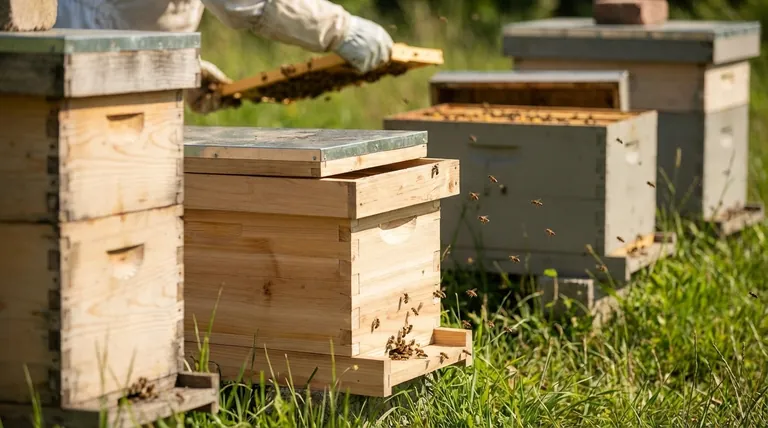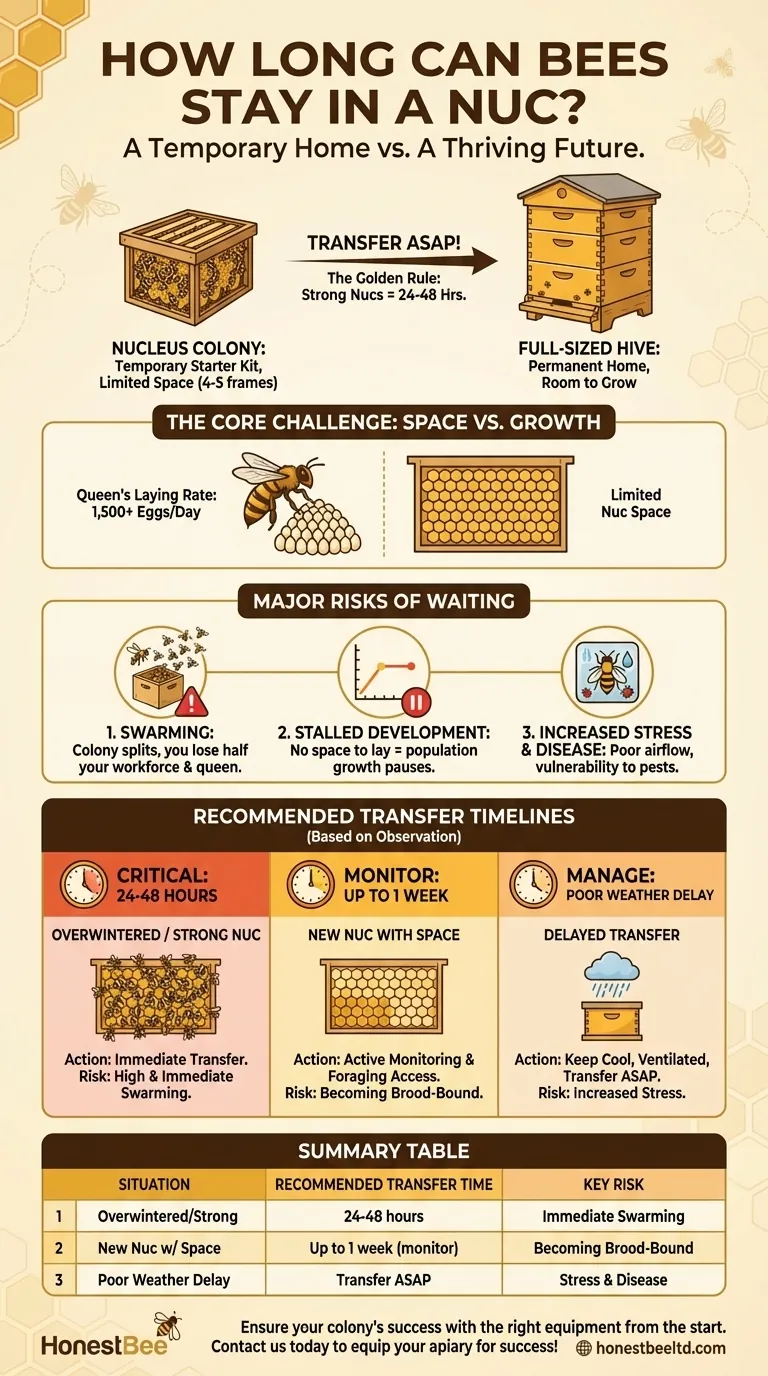Ideally, you should transfer your bees from a nucleus box (nuc) into a full-sized hive as soon as possible. While a colony can survive in a nuc for a week or slightly more if conditions are perfect and the entrance is open for foraging, this is a highly temporary solution. For a strong or overwintered nuc, you should aim to complete the transfer within 24 to 48 hours to prevent serious issues.
A nucleus colony is a starter kit, not a permanent home. The central challenge is that a nuc's limited space directly conflicts with a healthy colony's instinct to expand, creating a high-risk situation that can lead to the loss of your bees.

Why a Nuc is a Temporary Home
A nuc is designed for transporting bees and giving a new colony a head start. It is not designed for long-term habitation.
The Purpose of a Nucleus Colony
A nuc provides a balanced, functioning miniature colony: a laying queen, worker bees, brood (developing bees) in all stages, and stores of honey and pollen. Its purpose is to be a stable launchpad for a full-sized hive.
The Problem of Limited Space
A healthy honey bee colony is biologically programmed to grow. The bees will quickly draw out any remaining comb, fill cells with nectar and pollen, and give the queen every available cell to lay eggs. Once this space is filled, the colony has reached a critical decision point.
The Queen's Explosive Laying Rate
A productive queen can lay over 1,500 eggs per day. In the confined space of a 4 or 5-frame nuc, she can run out of empty cells to lay in within a matter of days, triggering a "brood-bound" condition that signals to the colony it's time to swarm.
Key Factors Determining Your Timeline
How long you have is not a fixed number of days but is dependent on the state of your specific colony.
Nuc Size and Strength
An overwintered nuc, which has survived the winter and is building up rapidly in spring, is often at maximum capacity upon arrival. It has no buffer and needs immediate transfer. A smaller, newly made spring nuc may have a few extra days of grace.
Brood Status
Open the nuc and look at the frames. If most of the comb is already filled with brood, honey, and pollen, your timeline is extremely short. If you see significant empty space or undrawn foundation, you have slightly more time.
Resource Flow and Foraging
If you open the entrance and the bees are actively foraging, they are bringing in resources at a rapid pace. While this is a sign of a healthy colony, it also means they are filling up their limited space even faster, accelerating the need for a transfer.
Understanding the Trade-offs and Risks of Waiting
Delaying the transfer from a nuc to a hive isn't a neutral act. It introduces significant risks that can undermine the success of your new colony.
The Primary Risk: Swarming
When a colony feels it has outgrown its home, its natural response is to swarm. The bees will raise a new queen, and the original queen will leave with up to half the workforce. In an overcrowded nuc, this can happen with stunning speed, and you may lose a large portion of your investment.
Stalled Colony Development
If the queen has no space to lay, the colony's population growth grinds to a halt. This pause in brood rearing creates a gap in the workforce three weeks later, weakening the colony just as it should be building strength for the main nectar flow or winter preparations.
Increased Stress and Disease
Overcrowding leads to poor air circulation and higher humidity inside the box. These conditions can increase stress on the bees, making them more vulnerable to pests like varroa mites and various brood diseases.
Making the Right Choice for Your Colony
Your decision on when to transfer the bees must be based on observation of the colony's condition and the resources you have available.
- If your nuc is an overwintered colony or appears packed with bees: Transfer them into a hive within 24-48 hours to prevent swarming.
- If you are delayed by several days of poor weather: Keep the nuc in a cool, shaded location, ensure it has ventilation, and open the entrance if temperatures allow so they can fly.
- If you absolutely must wait up to a week: You must manage the nuc actively by opening the entrance for foraging and inspecting every two days for signs of swarm preparations, like the creation of queen cells.
Your first and most important job with a new nuc is to give your colony the space it needs to thrive.
Summary Table:
| Situation | Recommended Transfer Time | Key Risk |
|---|---|---|
| Overwintered or strong nuc | 24-48 hours | High risk of immediate swarming |
| New spring nuc with space | Up to 1 week (with monitoring) | Risk of becoming brood-bound |
| Delayed by poor weather | Transfer as soon as possible | Increased stress and disease vulnerability |
Ensure your new colony's success with the right equipment from the start. A timely transfer is crucial, and having a durable, full-sized hive ready is the key to preventing swarming and promoting healthy growth. At HONESTBEE, we supply commercial apiaries and beekeeping equipment distributors with the high-quality, wholesale-priced supplies needed for a smooth and successful operation. Don't let limited space risk your investment—contact our experts today to equip your apiary for success!
Visual Guide

Related Products
- 5 Frame Wooden Nuc Box for Beekeeping
- HONESTBEE Advanced Ergonomic Stainless Steel Hive Tool for Beekeeping
- HONESTBEE Professional Long Handled Hive Tool with Precision Cutting Blade
- Professional Dual-End Stainless Steel Hive Tool for Beekeeping
- HONESTBEE Professional Multi-Functional Hive Tool with Ergonomic Wood Handle
People Also Ask
- What are the benefits of moving nuclei around the apiary? Master Strategic Hive Management
- What is the most common type of standard nuc? The 5-Frame Nuc Explained
- What are the benefits of using nucs for beginning beekeepers? Ensure a Successful First Hive with a Head Start
- What is the advantage of overwintering a nucleus? A Strategic Asset for Beekeeping Success
- How should the nuc be installed in the apiary? Ensure Colony Success from Day One



















